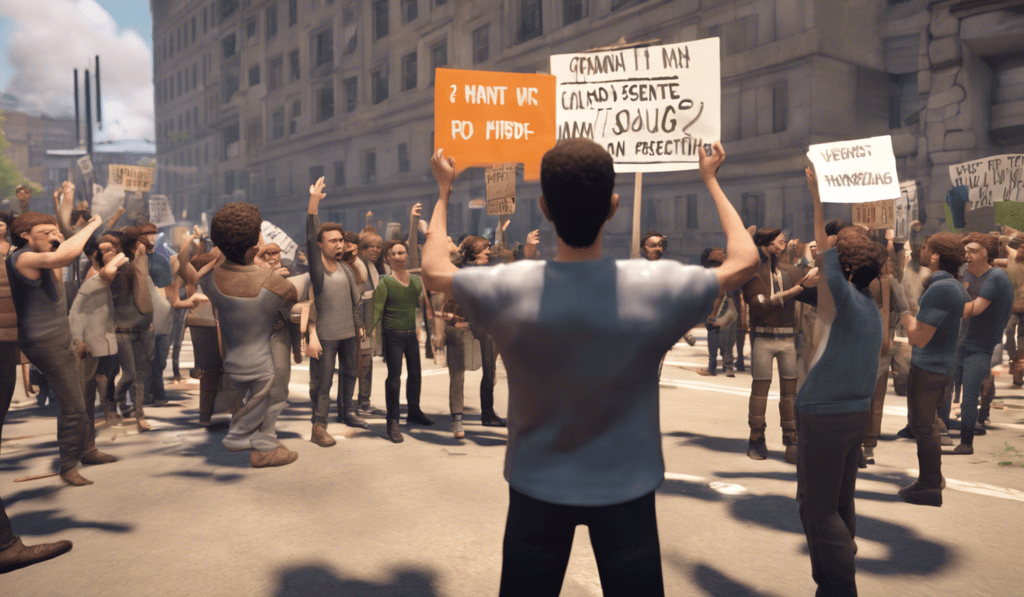The Concept of Game-Based News Simulation: An Application of Presence Theory (Theoretical Framework)
Presence Theory, initially rooted in virtual reality (VR) studies, refers to the phenomenon whereby users feel a sense of being physically present in a virtual environment.
SPRING QUARTER 2024
Mohammed Nashib
6/17/20245 min read


Introduction
In a time when information is spreading quickly but also incompletely and unfairly, new approaches for comparatively better news-consumption practices are paramount. One of these ideas, the Game-Based News Simulation (GBNS), aims to productively simulate past or present events in a gaming format. It does so by allowing users to ‘walk around’ in a third-person shooter mode and experience a real-time animated simulation of airplanes, tanks, gangs, rioters and police forces, on the site of events. More importantly, it gives users the opportunity to explore the geographical context of an event, side-stepping the burden of descriptive detail that can otherwise compromise the delivery of news in text or video format. The Presence Theory offers a theoretical foundation for the impact of immersive experience to user experience and understanding.
Presence Theory: An Overview
Inspired by research in virtual reality (VR), Presence Theory describes our sense of appearing at the point ‘where the rubber hits the road’. This experience of being transported to another place – often called feeling ‘present’ or ‘there’ – involves a set of related dimensions:
Spatial Presence: The sense of location within the virtual environment.
Social Presence: The feeling of social interaction with entities, whether human or AI.
Self-Presence: The sensation of personal influence and impact within the virtual space.
Narrative Presence: The extent to which users become absorbed in the storyline and context.
In GBNS, these dimensions can significantly affect the way users experience and engage with recreated events – with the potential for a deeper, more powerful engagement and enhanced understanding.
Application of Presence Theory in Game-Based News Simulation
Enhancing Spatial Presence
For instance, users can achieve an enhanced sense of spatial presence when navigating a space that is detailed and textured enough to strongly resemble the real-world location of the event. The use of third-person navigation helps users to explore locations, distinctive landmarks and terrains, thereby creating a greater sense of embodiment and a more realistic understanding of specific geographies.
Finally, and more importantly, the affordances of the interactivity and first-person perspective of digital media go much further than shifting the schlemiel image. Through the use of a 360-degree view and relatively detailed models, users are able to orient themselves in a way that is not possible with traditional media (personally, I’ve found this feature especially useful in freeware geography apps, such as iOS app Google Earth, where it has helped me to grasp the complex relationships between landmasses and the movements of transportation machinery).
For example, in a warzone model, users can see the spatial relationships between competing forces, civilian zones, military redoubts and so forth. These could enhance a user’s wider situational awareness and understanding of the underlying strategic logic of actors involved.
Enhancing Social Presence
From buffoonish autocratic billionaires to vulnerable civilians, military personnel, protesters and more, by making them AI-driven entities that interact with the users, there is a possibility of a richer social ecology emerging within the sim. Greater interactivity with such entities can endow the users with increased, perhaps authentic feeling of social presence, which means they end up living and breathing within a realistic world. This immersive authenticity is essential for humanizing the various threats of a crisis otherwise reduced to a two-dimensional news report, and better discerning the responses and reactions of humans to these threats.
Similarly immersive experiences can be created through dialogues and interactions with these agents which offer the users layered stories and viewpoints that enrich their understanding of the socio-political context of the event.
Enhancing Self-Presence
Users can cultivate self-presence in themselves by positioning them in a situation where they can exert some control over the environment – by having meaningful decisions to make in the game, by interacting with AI entities while playing, or by watching how their actions shape the environment they’re in. Though this might sound unromantic, it actually creates an increased feeling of agency, leading to a deeper psychological investment in the event, and a better ability to track and remember information, ultimately improving learning outcomes.
Enhancing Narrative Presence
Story, after all, can motivate users to invest more time in the simulation. And if GBNS can date events – by blending bona-fide data and interactive storytelling – it can provide users with a temporal framework. Users could then be able to track sequences of action and consequence, which is difficult to convey any other way.
Advantages Over Traditional News Formats
GBNS addresses several limitations inherent in traditional media: Eliminating Descriptive Complexity: Very often textual descriptions and videos fail to adequately convey the spatial and temporal dynamics of a scenario. A synthetic environment allows users to ‘read’ it in a sense other than descriptive, to fully grasp complex events through visual-spatial apprehension.
Interactive Learning: When you get to actually participate in the simulation, you will be more engaged with the enhancement of your cognitive skills, compared to the passive act of watching the news.
Higher Levels of Empathy and Emotional Engagement: Potentially higher levels of empathy and emotional engagement with the content can result because events are experienced viscerally in a full-body virtual environment.
Customization and depth: Exploration goes as deep or as shallow as the user wishes – nowhere can static articles or videos do that.
Challenges and Ethical Considerations
While GBNS presents an exciting innovation, it also poses challenges and ethical considerations:
Resemblance: The sign will only be taken seriously if it truly resembles the domain it represents. Any error in this simulation will be a form of misrepresentation. This suggests that the data must be carefully vetted and the sources credited.
Sensationalism: The immersive qualities of a simulation would make events even more exciting – and possibly less objective than they may be.
Access and Digital Divide: Making sure that the technologies needed for GBNS are accessible on an equitable and nondiscriminatory basis to avoid exacerbating the digital divide.
Privacy and security: Ensuring that user data and their interactions in the simulated environment is safe and secure.
Conclusion
The application of the concepts from Presence Theory in GBNS may be the next step in changing and improving news reporting. It is interactional and immersive, and it enriches, entices and educates players in a way that is impossible with static articles. The inclusion of spatial, social, self and narrative presence can transform the way we experience events, thereby providing an important tool for highlighting the underlying issues in traditional media. There are undoubtedly certain challenges and several dilemmas connected with this approach, but they need to be addressed so that GBNS can serve as an important and reliable source of news. This may be the future of news. And it may provide the foundation for interactive, immersive journalism in a virtual or even an augmented reality.
References
Lombard, M., & Ditton, T. (1997). At the heart of it all: The concept of presence. Journal of Computer-Mediated Communication, 3(2).
Schubert, T., Friedmann, F., & Regenbrecht, H. (2001). The experience of presence: Factor analytic insights. Presence: Teleoperators and Virtual Environments, 10(3), 266-281.
Slater, M., & Wilbur, S. (1997). A framework for immersive virtual environments (FIVE): Speculations on the role of presence in virtual environments. Presence: Teleoperators and Virtual Environments, 6(6), 603-616.
McMahan, A. (2003). Immersion, engagement, and presence: A method for analyzing 3-D video games. In Wolf, M. J. P. & Perron, B. (Ed.), The Video Game Theory Reader (pp. 67-86). Routledge.

